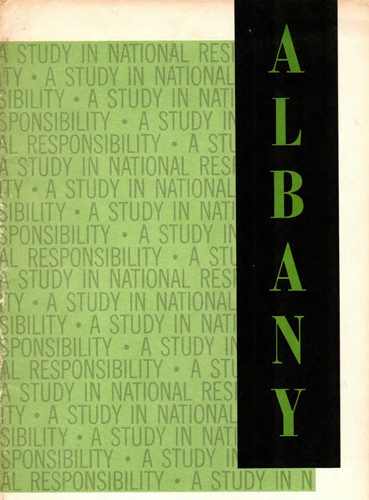Albany: A Study in National Responsibility (1962) was the outcome of “an investigation I did for the Southern Regional Council in Atlanta of the mass [civil rights] demonstrations in Albany, Georgia. My report focused on the failure of the federal government to enforce constitutional rights in Albany. It made national news, and when Martin Luther King, Jr. told reporters he agreed with my criticisms of the FBI, he aroused the special anger of [FBI Director] J. Edgar Hoover. My criticism went beyond the FBI to the national administration [of President John F. Kennedy], whose collaboration with the racist South—by inaction—was to become a persistent issue throughout the struggles of the movement for equal rights.” —Howard Zinn from The Zinn Reader: Writings on Disobedience and Democracy. Introduction by Leslie Dunbar.
Published by the Southern Regional Council, 1962.
Table of Contents
Page numbers are given for both the PDF file and the original text
- Introduction by Leslie W. Dunbar • p. 3 (v)
- Albany, Georgia • p. 7 (1)
- The December Demonstrations • p. 9 (3)
- The Truce Falls Apart • p. 11 (5)
- The Long Hot Summer • p. 15 (9)
- Black and White in Albany • p. 22 (16)
- The Chief of Police • p. 26 (20)
- Terrible Terrell • p. 29 (23)
- Where Was the Federal Government? • p. 32 (26)
- Postscript • p. 41 (35)
Excerpt: Postscript
By Howard Zinn
This report, based on time spent in Albany during the crises of December 1961 and the summer of 1962, owes a great deal to the excellent reporting of newspapermen, particularly: Claude Sitton of the New York Times; Pat Watters of the Atlanta Journal; Walter Rugaber of the Atlanta Journal; Fred Powledge of the Atlanta Journal; and Bill Shipp of the Atlanta Constitution. It owes much also to the many people, white and Negro, who spoke to me in Albany.
Perhaps there is a quality of harshness in the report. If so, it may come from some of the things I heard and saw in the Albany area. I recall particularly driving from dirt road onto dirt road deep into the cotton and peanut land of Lee County to talk to James Mays, a teacher and farmer. He showed me the damage done by 30 bullets which, hours before, in the middle of the night, had been fired through doors and windows and crashed into the walls around the heads of 19 sleeping persons, most of them children. With the coming of dawn he had quickly lettered a sign of protest and stood with it out on the main road to Leesburg in front of a Negro school. It was clear that, although he was a member of a nation whose power stretched around the globe and into space, James Mays was on his own.




